Looking for a fun, fast and fresh vehicle, but aren’t comfortable riding two wheels? Then Can-Am has just the vehicle you didn’t even known you needed, the new three-wheeled Spyder.
When BRP (Bombardier Recreational Products)—parent company of industry-leading powersport brands Sea-Doo, Ski-Doo and owners of Rotax—revived the Can-Am name early last year for its ATVs, it had aspirations beyond its existing off-highway empire. BRP wanted a chunk of the asphalt world as well, but where to start in an already bulging market? So they developed the Can-Am Spyder GS Roadster, a radical departure from almost any other vehicle on the market.
What is the Spyder? Is it more motorcycle, more car, or something entirely different? Throw a leg over the low 29-inch saddle, grab ahold of the bars and the rig feels very familiar. The view from the cockpit however, seems foreign due to those two front fenders protruding from either side in front. Thumb the starter button and the 106-horsepower, 998cc, liquid-cooled, fuel-injected, Rotax-built engine (similar to Aprilia's RSV Mille) comes to life with a nice low V-Twin thrum. Click the five-speed (plus reverse) transmission—in the normal motorcycle location—into gear, feed out the clutch and it's apparent that plenty of power is on tap to make the 700-pound Spyder leap forward when urged. We couldn't resist smoking the easily-lit rear tire.
The Spyder, however, isn't really defined by the engine. It's all about the unique “Y” chassis layout and the myriad of electronic gizmos that make it easy for anyone to operate. Designed for stability, it bridges the gap between a motorcycle and a sports car, and in a few states doesn't require anything other than a car driver's license to operate. Keeping everything under control is Can-Am's VSS (Vehicle Stability System) that consists of three sub-systems: ABS, traction control and stability control. Handling is the most interesting element of the roadster. Sitting in a traditional moto-seating position on a vehicle that doesn't lean is odd. The Spyder is more akin to riding an ATV or snowmobile than motorcycle, but provides enough performance to be a lot of fun. Perhaps the roadster's biggest advantage over a motorcycle is braking performance. At first it seems foreign due to the fact that there isn't a hand-operated brake lever (it's all right-foot actuated), but the stopping power and grip combined with ABS sheds speed, right now!
The Spyder will initially be available in 12 key-market states, but the phased rollout will eventually expand to cover all 5000-plus BRP dealers nationwide. An electronic-shift version—no clutch lever, either—will be an option. The suggested retail price for the standard-transmission vehicle is $14,999, with electric shift a $1500 premium. So if you’re looking for something new, the Spyder may be for you. Just don’t call it a trike. See the April issue of Cycle World for a complete First Ride impression.
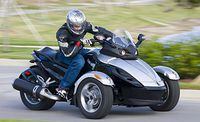
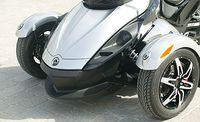
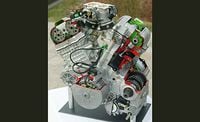
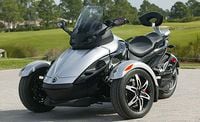
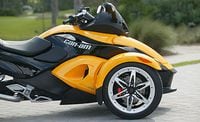
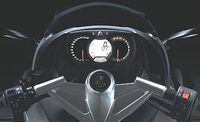
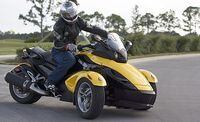
/cloudfront-us-east-1.images.arcpublishing.com/octane/NZKPFUWBHVGYJAFQPCXWAK6BZM.jpg)
/cloudfront-us-east-1.images.arcpublishing.com/octane/K5ZSQFMYQZHWRFXTTW4PEWMUDM.jpg)
/cloudfront-us-east-1.images.arcpublishing.com/octane/D2SOSBIQQRBPTERNSOJRAW3KYY.jpg)
/cloudfront-us-east-1.images.arcpublishing.com/octane/DS3Q5X2VJFFAJDK2PWB3Y7K6U4.jpg)
/cloudfront-us-east-1.images.arcpublishing.com/octane/4KBL4JAMYRFDPEINTWATDUH7OM.jpg)
/cloudfront-us-east-1.images.arcpublishing.com/octane/FXADK3MVSNBRTKJ2B7TPDCCJ5Y.jpg)
/cloudfront-us-east-1.images.arcpublishing.com/octane/M7L2CPXO55FRFMECW7QGDPGP6E.jpg)
/cloudfront-us-east-1.images.arcpublishing.com/octane/T4RWGLAEHVE2VCJZOTFTNGB2KA.jpg)
/cloudfront-us-east-1.images.arcpublishing.com/octane/JM4QGLAHWNGHPM74OEB7FVBFSY.jpg)
/cloudfront-us-east-1.images.arcpublishing.com/octane/BGPNXPDDYBHD3HL6YEZQOYHXTI.jpg)
/cloudfront-us-east-1.images.arcpublishing.com/octane/SND5GGQV4RDPPMZBSBEGIZ4SIY.jpg)
/cloudfront-us-east-1.images.arcpublishing.com/octane/XUDDAPYZMZEL5EDPVDJ2DTULWI.jpg)
/cloudfront-us-east-1.images.arcpublishing.com/octane/M7AU2L6GAVCJVHW57LIRPDAAUQ.jpg)
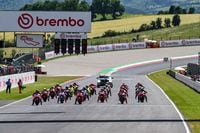
/cloudfront-us-east-1.images.arcpublishing.com/octane/JKEJY7P43JGD5C5NJO2VJQJPUM.jpg)
/cloudfront-us-east-1.images.arcpublishing.com/octane/YROKYJYUQVGPHCEMPTGBWDQCKQ.jpg)
/cloudfront-us-east-1.images.arcpublishing.com/octane/QIHEYR66TZDAPCGMWHCWCBC4XA.jpg)
/cloudfront-us-east-1.images.arcpublishing.com/octane/4FTBMNZL5BD2ZHY62XXRHJW6PI.jpg)
/cloudfront-us-east-1.images.arcpublishing.com/octane/L2BHKRCEMFDF7O3S4REZXPDH2E.jpg)
/cloudfront-us-east-1.images.arcpublishing.com/octane/QHENIV3HMJCTTCXQ6O5YPTNRZ4.jpg)
/cloudfront-us-east-1.images.arcpublishing.com/octane/K3VNQBIAKVGIHIGBRG7QKJYLVI.jpg)
/cloudfront-us-east-1.images.arcpublishing.com/octane/HRU64QXT3NH2DJOFBVI53XIKCE.jpg)
/cloudfront-us-east-1.images.arcpublishing.com/octane/4C5HHSNJCVDZXPIJTCJBVTE2MU.jpg)
/cloudfront-us-east-1.images.arcpublishing.com/octane/HBKK2TCOCZFIBIVKLKZFF5NXLQ.jpg)